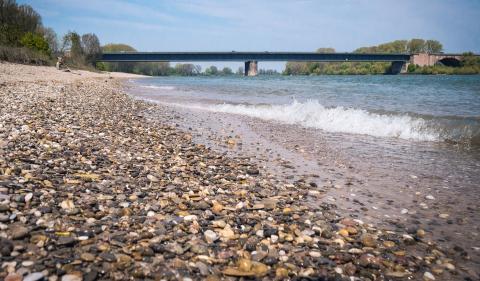
Sediment management in the Rhine catchment: Inventory of knowledge, research and monitoring, and an advice on research at the catchment scale
***Final report available at the bottom of this page in PDF***
Intensive human interventions in the morphology (channelization) and in the sediment regime (construction of transverse structures acting as sediment barriers, sediment extraction) have dramatically changed the flow and especially the sediment transport of the Rhine. The measures led to an increase in sediment transport capacity with a simultaneous reduction of sediment input, so that the Rhine River aims at a lower bed gradient by incising into its bed. This condition would bring the sediment transport capacity in line with the reduced sediment input and with the flow in the narrowed and straightened river course. However, this development has led to negative consequences for decades. They range from the exposure of less erodible sediment layers that impede navigation, to the scouring of bridge piers, the lowering of groundwater levels and to a variety of negative ecological consequences that lead to a sharp decline in biodiversity.
In order to optimise the efficiency of spending on countermeasures and the associated monitoring and research programmes, a coherent overview of all activities in the Rhine catchment and the state of knowledge on the sediment regime was required. Therefore, CHR (the International Commission for the Hydrology of the Rhine Basin) commissioned a project with the follow objectives:
1) provide a basin-wide overview on sediment issues in the Rhine and its main tributaries,
2) outline existing research and monitoring activities,
3) identify knowledge gaps and
4) propose a future research programme at the basin level.
During this project experts from six riparian countries working in the fields of sediment research and management were asked about their knowledge. The information obtained was supplemented by a comprehensive literature search. The review covered sediment-related problems, past and current research activities as well as monitoring programmes. Together with the interviewed experts, the existing activities were investigated for research and monitoring gaps.
Several research topics, each consisting of research questions, could be identified. Three project ideas were defined that should be realised primarily in the near future:
1) Influence of climate change and land use change on the sediment regime,
2) Alteration and improvement of sediment balance and continuity, sediment transport, and morphology (in the context of the spatial and temporal development of river engineering and management in the Rhine River and major tributaries), and
3) national and bilateral projects on sediment transport processes and management.
The results of this study also form a scientific building block for the activities in the ICPR, on the subject of sediment management, as envisaged in the Rhine 2040 Plan of the ICPR.
The final report of this study can be found in PDF at the bottom of this page. In 2022, we will further explore how to follow up on this subject. For this purpose, discussions will be held with different stakeholders such as the other Rhine River Commissions the ICPR and the CCNR.